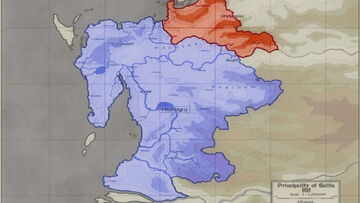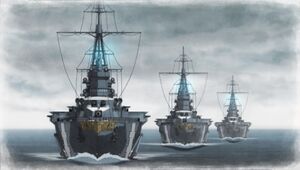| "Valkyria, Valkyria May the bloodline live forever Valkyria, Valkyria Bless and protect our fertile land" -Excerpt from the anthem of the Principality of Gallia- |
Full of nature and rich in Ragnite ore, the Principality of Gallia is a small independent nation which borders the Empire to the east and the Federation on its western edge. It's also the home land to the protagonists and the main setting in the main Valkyria Chronicles series.
Overview

Map of Gallia in 1935 (during the early stages of the Empire's invasion)
This small, central, Europan nation is a constitutional monarchy, ruled by House Randgriz, the hereditary sovereign of Gallia. The first ruling ancestor of the house, revered as the legendary hero of the ancient War of the Valkyrur, built a castle on the site of what is now the capital city Randgriz, establishing it as the seat of Gallian rule.
Despite its size of only 38,567 sq. km and a population of just over 4,430,000, it boasts a rich and unique culture. The official currency is the Ducat (DCT).
Internationally, Gallia is characterized by its policies of armed neutrality and universal conscription and is notable amongst smaller independent states for its success in declining to ally themselves to either of the warring superpowers that border it.
History
The nation was formally born in the 3rd Century, when Castle Randgriz was built and rule over surrounding areas began.
When the Empire invaded Gallia at the turn of the 19th Century, the king renounced his crown, instead ruling over an autonomous region within the Empire as archduke. But as democratic movements swept western Europa, the archduke harnessed that energy in Gallia to push for freedom from the Empire, resulting in the War of Gallian Independence.
Stretched thin between multiple fronts, the Empire was unable to maintain its hold, and the small nation rose as the independent Principality of Gallia, declaring neutrality and establishing a system of universal conscription.
Topography
With the sea at its north and west and thick forests shielding it to the south, Gallia is naturally fortified against invasion, historically allowing it to repel even significantly larger foes.
Hilly plains cover sixty percent of the nation's land, and its mountains contain a rich store of ragnite ore, a valued source of energy. Large cities dot the flatlands to the north, while the rest is largely occupied by lush farmland.
Gallia enjoys a temperate oceanic climate with little variation in rain levels throughout the year, and the soil is highly fertile. Because growing conditions for livestock and grain are equally favorable, Gallia practices a mixed form of agriculture.
Regions, Cities & Areas of Interest
- Randgriz: The capital of Gallia since its days as a monarchy, this ancient city has the longest history of any in Europa.
- Anthold: A harbor city on the Sea of Gallia in the South.
- Bruhl: This small town lies on the Imperial border at the eastern edge of Gallia.
- Fouzen: As one of Gallia's richest mining sites, this industry capital grew hand in hand with the evolution of ragnite science.
- Ghirlandaio: A very mountainous area at the northern border of Gallia.
- Kloden Wildwoods: This expansive primeval forest stretches across Gallia's south, forming a natural border with the Empire. Part of this region is the Leanbluff Forest, a hilly, wooded area to the east of Anthold.
- Lanseal Military Academy: The primary military academy in Gallia.
- Mellvere: A trade city situated on the River Mais in southern Gallia.
- Yuell: A medium sized city in central Gallia which grew around Yuell University.
- The Arlem Region: A plains area south of Mellvere with gently sloping terrain and fertile soil perfect for farming.
- The Barious Desert: An arid desert devoid of all vegetation covers the eastern Gallian basin area, several tens of kilometers across. The Temple of the Valkyrur is located in this area.
- The Daws Desert: A wasteland in southern Gallia.
- The Diebal Mountains: A mountain range near the border in southern Gallia.
- The Doerfein Mining Quarter: A series of mines spread throughout the Doerfein Mountains southeast of Yuell.
- The Great Vasel Bridge: A massive iron drawbridge spans the Vasel River.
- The Marberry Shore: One of several stretches of open shore north of the Fouzen industrial region.
- The Naggiar Plains: Few areas within Gallia have been the grounds for more battles through history than the sweeping Naggiar Plains, found in the nation's northeastern region.
- The Roendahl Canyon: A canyon in the upstream region of the River Mais east of Mellvere.
- Hafen: A city near the borders with the Empire.
Armed Forces
See also: Gallian Military Ranks and Insignia.

Gallian Navy
Gallia has a modestly small army compared to the other Europan powers, on account of its small population. As a result, Gallia relies heavily upon conscription to bolster its forces during times of war. Gallia is also known to have basic weapons training in schools, colleges, even universities as compulsory subjects, to ensure that Gallia's citizens are ready to be drafted at any time. The Gallian military focuses entirely upon weapons and tactics designed for defensive warfare.
The military has two main branches; the regular Army and the Militia. The regular Army is Gallia's full time military force, 80,000 strong and made up of well trained and disciplined soldiers, while the Militia is a force raised exclusively in wartime, made up of citizens who are drafted in with little training besides the subjects learned at school. Due to their inexperience at warfare and low levels of training most Militia members have (aside from veterans of previous conflicts), the regular Army tend to look down upon them and regard them as little use for anything more than cannon fodder. Gallia also has a Navy which is maintained by 10,000 Naval personnel. The Gallian Army also has 2,000 Military Police personnel.
The city of Randgriz also maintains its own force of soldiers, the Royal Guard, who act as the city's defence force and as the personal bodyguard of the Archduke/duchess.
Real-World References
- Gallia seems to be based largely on the Low Countries (comprising modern Belgium, The Netherlands and Luxembourg ) with additional French and Swiss influences (in terms of "military competency for a minor power in World War II", however, it most resembles Finland, both in terms of history and in terms of military structure). "Gallia" itself was the Latin name for the part of real-life Europe now comprised of France, northern Italy, Belgium, The Netherlands, Switzerland, Luxembourg and Monaco.
- The ducat is a gold coin that was used as a trade coin throughout Europe before World War I.
- Some cities in Gallia are named after real places in The Netherlands. For example, there are places in Gallia called Meppel, Terneuzen and Zwolle, which are both real cities in the Netherlands. Also, the town of Bruhl is a real town on the border between the Netherlands and Germany.
- The prevalence of windmills in the town of Bruhl are a reference to a cultural aspect of Dutch landscape sights.
- Gallia's strategic location as a route between the Empire and the Federation is a parallel to Belgium's strategic placement as the door to Europe between Latin and Germanic Europe as well as her buffer role between France and Germany.
- Much like The Netherlands and Belgium Gallia is a constitutional monarchy as of the 1930s, and in its history it broke away from the larger East Europan Empire (much like the Low Countries asserted independence from the wider German Empire in Europe's history). The Archduke/Duchess of Gallia, however, seems to possess somewhat greater power than "real" counterparts of similar time periods, since Cordelia, at least, acts as Head of Government as well as Head of State.
- The neutrality of Gallia is also based on Belgium's neutrality during World War 1 and 2. Like Gallia, Belgium was invaded in both the First and Second World Wars by Germany despite being a neutral nation. In the First World War, the Belgians, like the Gallians, managed to hold onto a small part of their nation and the Belgian army stayed in the field fighting the occupation until the war ended in 1918. In WW2, Belgium was successfully occupied by the Germans but, like Gallia, the Belgians fought for their independence.
- The Kloden Forest is based upon the Ardennes Forest located on the territories of Belgium, Luxembourg and France. The chapter Kloden Wildwood is based on the Battle of the Bulge.
- Gallia's practice of universal national conscription mirrors Switzerland's system of compulsory military service, the main exceptions being that in the Swiss system, weapon and combat training aren't taught in schools and compulsory conscription is applicable only to males (although females are welcome to volunteer for armed forces training).
- The location of Gallia in the continent of Europa roughly corresponds to the location of Estonia and Latvia in the continent of Europe in real life.
Trivia
- The northwestern part of Gallia resembles a unicorn's head, which may be a reason why the unicorn is the nation's symbol.
- The total population of Gallia in the original Japanese PS3 edition of Valkyria Chronicles was 4,320,000. However, in the English PS3 localization the population became 430,000.
- 430,000 is less than that of most large cities today, and thus is somewhat comically small for a nation of its size (Belgium and The Netherlands combined, which serve as Gallia's largest inspiration and seem to be of roughly equal size to Gallia when put together, support a population of over 25 million today, and still had easily 15 million at the outset of World War II [1][2]). Given the number of fatalities, scope of battles and the number of characters that appear in all three games, it has been assumed in some circles that the given number is simply in error, possibly due to the English localization team not wanting Gallia to seem "too big" or a typo.
- As the Japanese language organize decimal digits in groups of fours (1万 = 10^4, 1億 = 10^8, 1兆 = 10^12 etc) as opposed to groups of threes (thousand = 10^3, million = 10^6, billion = 10^9 etc), it was also possible that the population in original Japanese, which was written as "432 万", was carelessly translated as "432 thousand" in English.
- In one of the newspapers from Writing on the Wall, a Gallian coastal city named Valua is mentioned. Seeing as both the Valkyria Chronicles series and Skies of Arcadia are both published by Sega, this could be an easter egg reference to the city of Valua from Skies of Arcadia.
- According to the Valkyria Chronicles Design Archive, Gallia was loosely based off of The Netherlands.

